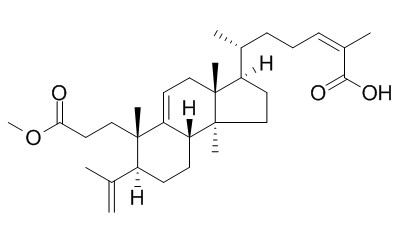Kadsuric acid 3-methylester
Kadsuric acid 3-methylester is a natural product from Kadsura longipedunculata Finet.et Gagnep.
Inquire / Order:
manager@chemfaces.com
Technical Inquiries:
service@chemfaces.com
Tel:
+86-27-84237783
Fax:
+86-27-84254680
Address:
1 Building, No. 83, CheCheng Rd., Wuhan Economic and Technological Development Zone, Wuhan, Hubei 430056, PRC
Providing storage is as stated on the product vial and the vial is kept tightly sealed, the product can be stored for up to
24 months(2-8C).
Wherever possible, you should prepare and use solutions on the same day. However, if you need to make up stock solutions in advance, we recommend that you store the solution as aliquots in tightly sealed vials at -20C. Generally, these will be useable for up to two weeks. Before use, and prior to opening the vial we recommend that you allow your product to equilibrate to room temperature for at least 1 hour.
Need more advice on solubility, usage and handling? Please email to: service@chemfaces.com
The packaging of the product may have turned upside down during transportation, resulting in the natural compounds adhering to the neck or cap of the vial. take the vial out of its packaging and gently shake to let the compounds fall to the bottom of the vial. for liquid products, centrifuge at 200-500 RPM to gather the liquid at the bottom of the vial. try to avoid loss or contamination during handling.
Med Sci Monit.2019, 25:9499-9508
Biomed Chromatogr.2016, 30(10):1573-81
Biomolecules.2023, 13(2):227.
Food Chem.2023, 427:136647.
J Food Sci.2021, 86(9):3810-3823.
Cytotechnology.2017, 69(5):765-773
Legume Science2021, 3(4): e101.
Korean J. Medicinal Crop Sci.2023, 31(5):283-289.
Comput Biol Chem.2019, 83:107096
Front Plant Sci.2020, 10:1705
Related and Featured Products
Helvetica Chimica Acta, 2010 , 91 (5) :856-861.
Terpenoids from Two Dicranopteris Species[Reference:
WebLink]
METHODS AND RESULTS:
Two new compounds, (6S,13S)-6-{[β-D-glucopyranosyl-(1→4)-α-L-rhamnopyranosyl]oxy}cleroda-3,14-dien-13-ol (1) and Kadsuric acid 3-methylester (2), together with nine known compounds, (6S,13E)-6-{[β-D-glucopyranosyl-(1→4)-α-L-rhamnopyranosyl]oxy}cleroda-3,13-dien-15-ol (3), (6S,13S)-6-[6-O-acetyl-β-D-glucopyranosyl-(1→4)-α-L-rhamnopyranosyl]oxy}-13-{[α-L-rhamnopyranosyl-(1→4)-β-D-fucopyranosyl]oxy}cleroda-3,14-diene (4), (6S,13S)-6-{[6-O-β-D-glucopyranosyl-(1→4)-α-L-rhamnopyranosyl]oxy}-13-{[α-L-rhamnopyranosyl-(1→4)-β-D-fucopyranosyl]oxy}cleroda-3,14-diene (5), 15-hydroxydehydroabietic acid (6), 15-hydroxylabd-8(17)-en-19-oic acid (7), junicedric acid (8), (4β)-kaur-16-en-18-oic acid (9), (4β)-16-hydroxykauran-18-oic acid (10), and (4β,16β)-16-hydroxykauran-18-oic acid (11) were isolated from the fronds of Dicranopteris linearis or D. ampla.
CONCLUSIONS:
Their structures were established by extensive 1D- and 2D-NMR spectroscopy. Compounds 1 and 3–8 showed no anti-HIV activities.



